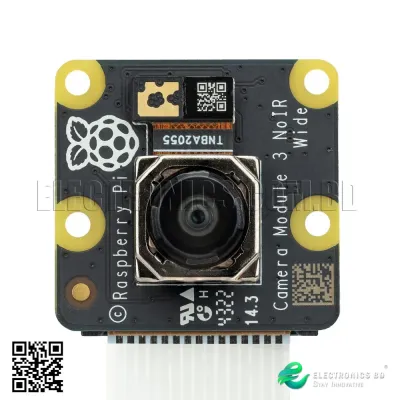





Specifications:
 Safe Shopping
Safe Shopping
Data Protection.
 Fast Delivery
Fast Delivery
Delivery all over Bangladesh.

Guarantee safe & secure checkout
The "Raspberry Pi Camera Module 3 for Raspberry Pi Zero, 1, 2, 3, 4, 5 +" is a versatile camera module designed to be compatible with multiple models of Raspberry Pi single-board computers. It is specifically engineered to seamlessly integrate with Raspberry Pi Zero, 1, 2, 3, 4, and 5, providing users with a convenient imaging solution for various projects and applications.
This camera module features a high-quality back-illuminated, stacked CMOS 12-megapixel Sony IMX708 image sensor, ensuring excellent image quality and clarity. It comes equipped with advanced features such as Phase Detection Autofocus (PDAF) and built-in 2D Dynamic Defect Pixel Correction (DPC) for rapid autofocus and image correction.
With a resolution of 11.9 megapixels and support for various video modes, including 1080p50 and 720p100, the Camera Module 3 offers flexibility for capturing still images and videos in different scenarios.
The module is compact in size and includes a ribbon cable for easy connectivity to Raspberry Pi boards. However, it's important to note that for Raspberry Pi Zero models, a specific Raspberry Pi Zero camera cable is required for connection, as the standard cable supplied with the camera may not be compatible with the smaller Raspberry Pi Zero camera connector.
Overall, the Raspberry Pi Camera Module 3 for Raspberry Pi Zero, 1, 2, 3, 4, and 5 + is a versatile and high-performance camera module that expands the capabilities of Raspberry Pi boards, making it suitable for a wide range of applications, including photography, videography, surveillance, and machine vision.
The Raspberry Pi Camera Module 3 for Raspberry Pi Zero, 1, 2, 3, 4, and 5 + works by capturing images and videos using its integrated image sensor and processing them through the connected Raspberry Pi board. Here's how it works:
Image Sensor: The camera module features a back-illuminated, stacked CMOS 12-megapixel Sony IMX708 image sensor. This sensor captures light and converts it into digital signals, forming images with high resolution and quality.
Processing: The captured image data is processed by the Raspberry Pi board to perform tasks such as autofocus, white balance adjustment, and image enhancement. The board utilizes its processing power and software capabilities to optimize the captured images and videos.
Connectivity: The camera module connects to the Raspberry Pi board via a ribbon cable. This cable transmits both power and data between the camera module and the board, enabling seamless communication and control.
Control: The Raspberry Pi board controls various aspects of the camera module's operation, including capturing images, recording videos, adjusting settings, and processing the captured data. Users can interact with the camera module through software applications and programming interfaces provided by the Raspberry Pi operating system.
Integration: The camera module integrates with the Raspberry Pi ecosystem, allowing users to incorporate it into their projects and applications. Whether it's for photography, videography, surveillance, or machine vision, the camera module expands the capabilities of Raspberry Pi boards and enables a wide range of creative possibilities.